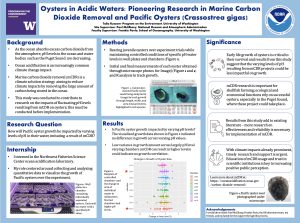Oysters in Acidic Waters: Pioneering Research in Marine Carbon Dioxide Removal and Pacific Oysters (Crassostrea gigas)
Marine carbon dioxide removal (mCDR) is a climate solution strategy with varying methods that aim to remove excess carbon dioxide from the atmosphere through marine removal. Much of the atmospheric carbon dioxide is stored in the ocean, creating issues such as ocean acidification. However, before mCDR can be implemented, more environmental impact research must be done. Pacific oysters are one of many species that would be impacted. The purpose of this research is to find impacts of variable pH on the survival and growth of Pacific oysters. To accomplish this task, I interned at NOAA’s ocean acidification lab. I reared Pacific oyster seeds in experimental trials that involved controlled laboratory environments with water at various pH levels to find impacts on juvenile oyster growth. I tracked the growth through microscope photography and photo analysis in software such as ImageJ and RStudio in order to create visuals and find results. These results can help find significant correlations between the growth rates of the juvenile oysters and varying levels of pH, linking the risks of mCDR’s effectiveness to the potential impacts. Usage of mCDR has the potential to be a very valuable method in combating climate change, especially in the local Puget Sound, where ocean acidification is a major concern. Results showing significant impact on the juvenile growth of Pacific oysters from our lab can provide more baseline understanding for future research in the field.
